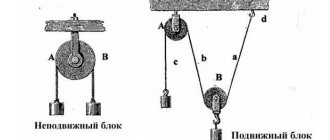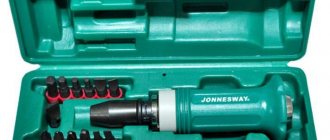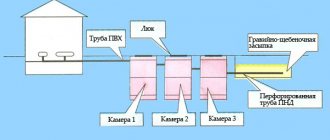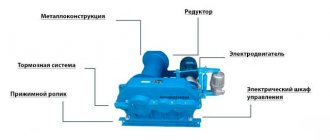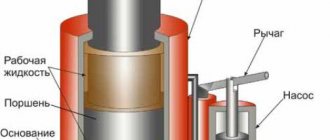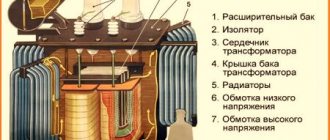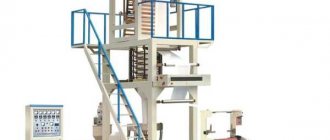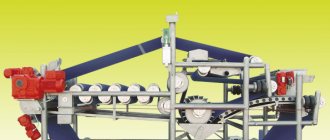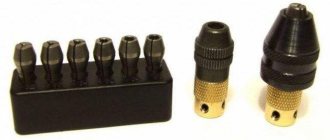A chain hoist is a portable block system designed for lifting and moving loads of varying degrees of severity. This device is used in the construction industry, logistics, mountaineering and during rescue operations. To make a chain hoist with your own hands, you need to know the design features of this device, methods of attaching ropes to a forklift, and reeving technology.
General information about pulley hoists
A pulley block consists of 2 or more pulleys (blocks) connected using rope ropes or chains:
- Fixed pulley. This block is attached to strong static elements or special equipment. It includes several videos. Each of them carries ropes, metal ropes or iron chains. A fixed pulley distributes pressure between structural elements. The amount of pressure on each rope is determined by the number of rollers.
- Movable pulley. This block is attached to the load and is used to maintain the operation of the lifting mechanism. It is equipped with a hook, carabiner and magnet. A movable pulley, attached to a load, can benefit from effort.
Simple pulleys can consist of 1 pulley and rope. In them, the roller is located above the load: on the ceiling, beam or support. The first end of the rope is connected to the hook and goes down to the load being lifted. A man pulls on the other end of a rope, lifting a heavy object. Complex lifting devices include several simple pulleys and provide greater gains in strength.
The operating principle of pulley blocks is based on the rule of leverage. A rope is thrown over a stationary pulley. The load is raised to a height by applying forces commensurate with the weight of the object being lifted. The length of the rope or chain should be comparable to the height to which the load is lifted. To reduce the amount of effort required, it is necessary that the moving block moves parallel to the load.
There are the following types of pulleys:
- Purpose: power and speed. Power mechanisms are designed to transport heavy objects. They provide gains in strength at the expense of distance and speed. High-speed pulleys allow you to speed up the process of transporting light loads by reducing the applied effort.
- According to the complexity of the scheme. In simple schemes for lifting loads using blocks, all rollers are connected in series using 1 chain or rope. Complex systems are characterized by high performance. The gain in strength comes from fewer blocks.
Pull blocks are used for the following operations:
- For tensioning cables, power lines and suspended structures.
- Together with a winch for pulling out a car or other type of transport stuck in mud or ground.
- For carrying out rigging work when transporting heavy structures.
Various types of cranes, hydraulic and electric drives are equipped with pulleys. They were also used in older elevator prototypes.
Lifting loads without special equipment - how to calculate and make a chain hoist with your own hands
Lifting machines are designed to help a person lift something heavy to a height.
Most lifting mechanisms are based on a simple block system - a pulley system. It was known to Archimedes, but now many people do not know about this brilliant invention. Remembering your physics course, find out how such a mechanism works, its structure and scope. Having understood the classification, you can begin to calculate.
For everything to work out, here are instructions for constructing a simple model.
Block system - theory
The invention of the chain hoist gave a huge impetus to the development of civilizations.
The block system helped build huge structures, many of which have survived to this day and puzzle modern builders.
Shipbuilding also improved, and people were able to travel great distances. It's time to figure out what it is - a chain hoist and find out where it can be used today.
Structure of the lifting mechanism
A classic chain hoist is a mechanism that consists of two main elements:
A pulley is a metal wheel that has a special groove for a cable along its outer edge. An ordinary cable or rope can be used as a flexible connection.
If the load is heavy enough, ropes made of synthetic fibers or steel ropes and even chains are used. To ensure that the pulley rotates easily, without jumping or jamming, roller bearings are used.
All elements that move are lubricated.
One pulley is called a block. A pulley block is a system of blocks for lifting loads. The blocks in the lifting mechanism can be stationary (rigidly fixed) and movable (when the axis changes position during operation). One part of the pulley is attached to a fixed support, the other to the load. Movable rollers are located on the load side.
The role of the stationary block is to change the direction of movement of the rope and the action of the applied force. The role of the mobile is to gain strength.
How it works - what's the secret?
The operating principle of a pulley block is similar to a lever: the force that needs to be applied becomes several times smaller, while the work is performed in the same volume. The role of the lever is played by the cable. In the operation of a chain hoist, the gain in strength is important, so the resulting loss in distance is not taken into account.
Depending on the design of the pulley, the gain in strength may be different. The simplest mechanism of two pulleys gives approximately a twofold gain, of three - threefold, and so on.
The increase in distance is calculated using the same principle.
To operate a simple pulley, you need a cable twice as long as the lifting height, and if you use a set of four blocks, then the length of the cable increases in direct proportion to four times.
In what areas is the block system used?
A chain hoist is a faithful assistant in a warehouse, in production, and in the transport sector. It is used wherever force needs to be used to move all kinds of loads. The system is widely used in construction.
Despite the fact that most of the heavy work is performed by construction equipment (cranes), the chain hoist has found a place in the design of load-handling mechanisms. The block system (pulley block) is a component of such lifting mechanisms as a winch, hoist, and construction equipment (various types of cranes, bulldozer, excavator).
In addition to the construction industry, pulleys are widely used in organizing rescue operations. The principle of operation remains the same, but the design is slightly modified. Rescue equipment is made of durable rope and carabiners are used. For devices of this purpose, it is important that the entire system is quickly assembled and does not require additional mechanisms.
Classification of models according to different characteristics
There are many executions of one idea - a system of blocks connected by rope. They are differentiated depending on the method of application and design features. Get to know the different types of lifts, find out what their purpose is and how the device differs.
Classification depending on the complexity of the mechanism
Depending on the complexity of the mechanism, there are
- simple;
- complex;
- complex chain hoists.
A simple chain hoist is a system of series-connected rollers. All movable and fixed blocks, as well as the load itself, are combined by one cable. Even and odd simple pulleys are differentiated.
Even lifting mechanisms are those whose end of the cable is attached to a fixed support - a station. All combinations in this case will be considered even. And if the end of the rope is attached directly to the load or the place where the force is applied, this structure and all its derivatives will be called odd.
A complex pulley system can be called a pulley system. In this case, not individual blocks are connected in series, but entire combinations that can be used on their own. Roughly speaking, in this case one mechanism sets in motion another similar one.
The complex chain hoist does not belong to one or the other type. Its distinctive feature is rollers moving towards the load. The complex model can include both simple and complex chain hoists.
Classification according to the purpose of the lift
Depending on what they want to get when using a chain hoist, they are divided into:
The power option is used more often. As the name suggests, its task is to ensure a gain in strength. Since significant gains require equally significant losses in distance, losses in speed are also inevitable. For example, for a 4:1 system, when lifting a load one meter, you need to pull 4 meters of cable, which slows down the work.
The high-speed chain hoist, by its principle, is a reverse power design. It does not give a gain in strength, its goal is speed. Used to speed up work at the expense of the applied effort.
Multiplicity is the main characteristic
The main indicator that people pay attention to when organizing cargo lifting is the multiplicity of the pulley. This parameter conventionally indicates how many times the mechanism allows you to win in strength. In fact, the multiplicity shows how many branches of the rope the weight of the load is distributed over.
The multiplicity is divided into kinematic (equal to the number of kinks in the rope) and force, which is calculated taking into account the cable’s overcoming the friction force and the non-ideal efficiency of the rollers. The reference books contain tables that display the dependence of the power factor on the kinematic factor at different block efficiencies.
As can be seen from the table, the force multiplicity differs significantly from the kinematic one. With a low roller efficiency (94%), the actual gain in strength of a 7:1 pulley will be less than the gain of a six-fold pulley with a block efficiency of 96%.
How to make calculations for a chain hoist
Despite the fact that theoretically the design of a pulley hoist is extremely simple, in practice it is not always clear how to lift a load using blocks. How to understand what multiplicity is needed, how to find out the efficiency of the lift and each block separately. In order to find answers to these questions, you need to perform calculations.
Calculation of a separate block
The calculation of the chain hoist must be performed due to the fact that the working conditions are far from ideal. The mechanism is subject to frictional forces as a result of the movement of the cable along the pulley, as a result of the rotation of the roller itself, no matter what bearings are used.
In addition, flexible and pliable rope is rarely used on a construction site or as part of construction equipment. Steel rope or chain has much greater rigidity. Since bending such a cable when running against a block requires additional force, it must also be taken into account.
For the calculation, the moment equation for the pulley relative to the axis is derived:
SrunR = SrunR + q SrunR + Nfr (1)
Formula 1 shows the moments of such forces:
- Srun – force from the side of the escape rope;
- Srun – force from the oncoming rope;
- q Srun – force for bending/unbending the rope, taking into account its rigidity q;
- Nf is the friction force in the block, taking into account the friction coefficient f.
To determine the moment, all forces are multiplied by the arm - the radius of the block R or the radius of the sleeve r.
The force of the approaching and escaping cable arises as a result of the interaction and friction of the rope threads. Since the force for bending/extension of the cable is significantly less than the others, when calculating the effect on the block axis, this value is often neglected:
N = 2 Srun×sinα (2)
In this equation:
- N – impact on the pulley axis;
- Srun - force from the oncoming rope (taken to be approximately equal to Srun;
- α is the angle of deviation from the axis.
Calculation of the useful action of the block
As you know, efficiency is the efficiency factor, that is, how effective the work performed was. It is calculated as the ratio of work completed and work expended. In the case of a pulley block, the formula is applied:
ηb = Srun/ Srun = 1/(1 + q + 2fsinα×d/D) (3)
In the equation:
- 3 ηb – block efficiency;
- d and D – respectively, the diameter of the bushing and the pulley itself;
- q – rigidity coefficient of flexible connection (rope);
- f – friction coefficient;
- α is the angle of deviation from the axis.
From this formula it can be seen that the efficiency is affected by the structure of the block (through the f coefficient), its size (through the d/D ratio) and the rope material (q coefficient). The maximum efficiency value can be achieved using bronze bushings and rolling bearings (up to 98%). Sliding bearings will provide up to 96% efficiency.
How to calculate the efficiency of the entire system
The lifting mechanism consists of several blocks. The total efficiency of a pulley block is not equal to the arithmetic sum of all individual components. For the calculation, they use a much more complex formula, or rather, a system of equations, where all forces are expressed through the value of the primary S0 and the efficiency of the mechanism:
- S1=ηп S0;
- S2=(ηп)2 S0; (4)
- S3=(ηп)3 S0;
….
Since the efficiency value is always less than 1, with each new block and equation in the system, the value of Sn will rapidly decrease. The total efficiency of the pulley will depend not only on ηb, but also on the number of these blocks - the multiplicity of the system. Using the table, you can find ηp for systems with different numbers of blocks at different efficiency values of each.
How to make a lift with your own hands
In construction, during installation work, it is not always possible to fit a crane. Then the question arises of how to lift the load with a rope. And here a simple chain hoist finds its application. To make it and fully operate, you need to make calculations, drawings, and choose the right rope and blocks.
Preparation of the base - diagram and drawing
Before you start building a chain hoist with your own hands, you need to carefully study the drawings and choose a suitable scheme for yourself. You should rely on how it will be more convenient for you to place the structure, what blocks and cable are available.
It happens that the lifting capacity of the pulley blocks is not enough, and there is no time or opportunity to build a complex multiple lifting mechanism. Then double chain hoists are used, which are a combination of two single ones. This device can also lift the load so that it moves strictly vertically, without distortions.
How to choose a rope and block
The most important role in building a chain hoist with your own hands is played by the rope. It is important that it does not stretch. Such ropes are called static. Stretching and deformation of a flexible connection causes serious losses in work efficiency. For a homemade mechanism, a synthetic cable is suitable; the thickness depends on the weight of the load.
The material and quality of the blocks are indicators that will provide homemade lifting devices with the calculated load capacity. Depending on the bearings that are installed in the block, its efficiency changes and this is already taken into account in the calculations.
But how can you lift a load to a height with your own hands and not drop it? To protect the load from possible reverse movement, you can install a special locking block that allows the rope to move only in one direction - the desired direction.
Step-by-step instructions for lifting a load through a block
When the rope and blocks are ready, the diagram has been selected, and the calculations have been made, you can begin assembly. For a simple double pulley you will need:
- roller – 2 pcs.;
- bearings;
- bushing – 2 pcs.;
- clip for block – 2 pcs.;
- rope;
- hook for hanging cargo;
- slings - if they are needed for installation.
Step-by-step lifting of the load to a height is carried out as follows:
- Connect the rollers, bushing and bearings. They combine all this into a clip. Get a block.
- The rope is launched into the first block;
- The clip with this block is rigidly attached to a fixed support (reinforced concrete beam, pillar, wall, specially mounted extension, etc.);
- The end of the rope is then passed through the second block (movable).
- A hook is attached to the clip.
- The free end of the rope is fixed.
- They sling the lifted load and connect it to the chain hoist.
The homemade lifting mechanism is ready to use and will provide double the strength benefits. Now, to raise the load to a height, just pull the end of the rope. By bending around both rollers, the rope will lift the load without much effort.
Is it possible to combine a chain hoist and a winch?
If you attach an electric winch to the homemade mechanism that you build according to these instructions, you will get a real do-it-yourself crane. Now you don’t have to strain at all to lift the load; the winch will do everything for you.
Even a manual winch will make lifting the load more comfortable - you don’t need to rub your hands on the rope and worry about the rope slipping out of your hands. In any case, turning the winch handle is much easier.
In principle, even outside a construction site, the ability to build a basic pulley system for a winch in field conditions with a minimum of tools and materials is a very useful skill. It will be especially appreciated by motorists who are lucky enough to get their car stuck somewhere in an impassable place. A hastily made pulley will significantly increase the performance of the winch.
It is difficult to overestimate the importance of pulley hoists in the development of modern construction and mechanical engineering. Everyone should understand the principle of operation and visually imagine its design. Now you are not afraid of situations when you need to lift a load, but there is no special equipment. A few pulleys, a rope and ingenuity will allow you to do this without using a crane.
Calculation of the chain hoist
Before manufacturing a chain hoist, it is necessary to calculate the main technical characteristics of the load-lifting structure. Calculations are required for drawing up drawings and are made according to the parameters of the working premises and the weight of the load.
To determine the loads affecting the block system during operation, it is necessary to calculate the parameters acting on individual blocks:
- The force of the load being lifted (SC).
- Engine tractive force (SM).
- Deflection angle (α). When calculating the parameters of a pulley, this characteristic can be neglected, because modern devices do not have a deflection angle.
- Block diameter (D).
- Bushing diameter (d).
The equation used to find the moments of force is as follows: SM * R = SC*R + l*SC*R + N* g*d/2, where:
- SM * R is the moment of force with which the load affects the block system.
- l – coefficient characterizing the rigidity of the hand rope when bending around the roller. It depends on the structure of the rope turns and is determined experimentally.
- Pulley axle load. It is determined by the formula: 2*SC*R.
- g – coefficient characterizing the friction force of the pulley bushing.
Homemade chain hoist with your own hands - Metals, equipment, instructions
Lifting machines are designed to help a person lift something heavy to a height. Most lifting mechanisms are based on a simple block system - a pulley system.
It was known to Archimedes, but now many people do not know about this brilliant invention. Remembering your physics course, find out how such a mechanism works, its structure and scope. Having understood the classification, you can begin to calculate.
For everything to work out, here are instructions for constructing a simple model.
Methods for attaching a rope to a lifting mechanism
The cargo rope allows you to automatically fix the lifted load, which affects the passage of knots. It must be filled in such a way that there is no possibility of chafing due to frequent contacts with other parts of the lifting structure. There are 3 main methods of attaching a rope to a pulley system:
- Using gripping units made from cords with a diameter of up to 8 mm. They have high strength and begin to slide off the rope only when the load is 10 – 13 kN. The gripping knots do not subject the rope to deformation. With prolonged use, they melt the braid and stick to the rope, becoming fuses.
- Using a general direction clamp. It is recommended for use on wet and icy ropes. The clamp begins to slide without deformation at a load of 6-7 kN.
- Using a personal clamp. It slips under loads of 4 kN, breaking the braid.
To secure crane ropes, you need to secure 1 end of the rope with a lock or cable clamp. On winches, the cable is fixed to special fastenings using a wedge and a clamping bar.
Changing the ratio
Pulley hoists (their purpose and design have remained essentially unchanged over the years of existence) allow the introduction or removal of additional blocks from the system. Due to this, the required multiplicity is obtained. If the multiplicity is even, then the free end of the rope is fixed to a stationary structural element. If the multiplicity is odd, then the same end is attached to the clip with a hook.
In power pulleys, increasing the multiplicity allows you to reduce the diameter of the rope and, accordingly, the dimensions of the drum and blocks. All this ultimately leads to a decrease in the total mass of the entire system and a decrease in the gear ratio. But at the same time, a larger length of rope will be required.
The simplest do-it-yourself lifting mechanism
In home workshops you can make a simple chain hoist from scrap materials. It is capable of lifting light loads and can only be used for occasional jobs. To make a chain hoist with your own hands, you need to purchase the following components:
- Threaded studs made of metal materials.
- 2 videos.
- Bearings.
- Rope or cable.
- Hook.
A bearing is installed on a steel stud, a nut is screwed on and locked. A hook is attached to the stud to reduce the effort required to rotate the homemade shaft. The first end of the rope is located on a static platform. To lift the load, you need to pull the second end of the cable up. For ease of operation, it is recommended to make an additional block and pass a rope through it. This will allow you to connect the rope to the winch and fix the transported object in an intermediate position.
general information
Let's try to study the chain hoist in as much detail as possible. What is this from a technical point of view? At its core, it is a group of blocks assembled into special cages through which either a chain or a rope passes. The simplest pulley is one block with a traction element stretched through it. This version of the scheme allows you to halve the traction force required to move the load.
Refilling chain hoists
Reeving is a procedure for changing the location of pulleys and the distance between them. The purpose of this operation is to regulate the speed and height of lifting loads in accordance with a certain pattern of cable passage through the blocks of the lifting mechanism. There are the following types of reserve:
- One-time. 1 rope is attached to the hook, which is passed through all the fixed blocks and wound onto the drum.
- Double. The first end of the rope is attached to the head of the crane's rotating element, the second - to the winch. This reeving method can be used on jib-type cranes.
- Quadruple. 2 working branches of the cable are routed through the working boom pulleys. Adjacent pulleys are fastened together using a static block installed on the platform stand. This reeving method is used for heavy-duty applications.
History of creation and definition
No one knows for sure when exactly mechanisms for moving heavy objects in space appeared and began to be used. First of all, we note: a pulley system (technical literature can also tell you what it is) is a system of blocks and ropes that can significantly simplify and speed up planned work with heavy objects.
The study of such architectural monuments as the Cheops pyramids in Egypt, the Great Wall of China and other ancient structures clearly confirms that pulleys, the purpose and design of which will be discussed below, were invented several thousand years ago. It is quite obvious that they were initially characterized by primitiveness.
Peculiarities
Absolutely any chain hoist, the principle of operation of which is generally similar to the operation of a lever, is good because it does not require any special skills from the user, but it requires extreme caution, since, like any other lifting mechanism, it is fraught with danger and can injure . In addition, the operation of pulley blocks shows that the traction elements used in their systems do not have ideal flexibility and are endowed with some rigidity. That is why the advancing branch of the rope is not able to immediately fall into the stream of a block or drum, and the running branch cannot immediately straighten out. This is best seen when using steel ropes.
Multiplicity of chain hoist
Let's complicate the scheme. No one is stopping us from using not two blocks, but three, four or more.
The figure shows a double chain hoist. The load on the engine is reduced by approximately four times. “Approximately” because we lose part of the effort due to friction between the rope and the block. The unit efficiency is usually 0.97.
The multiplicity of the pulley is precisely the ratio of the forces of the cable on the drum and near the load. In the example above, the multiplicity of the pulley is four.
Chain hoist diagram
Here is the simplest diagram of a chain hoist.
Circles are blocks. A large drive circle, or rather a drum, of a load-lifting crane. The end of the cable is not fixed to the crane hook, but to a surface that is stationary relative to the crane. Such a surface can be a crane boom or, if we talk about tower cranes, a carriage. The lower block is not fixed to the crane in any way and is movable relative to it. These are the two simplest schemes for constructing a chain hoist.
What loads arise in this case?
Calculation of the chain hoist
It would be more correct to ask how the load on the engine and on the rope itself will change. In our case, it will decrease by half. Of course, you can cite formulas and school examples known since the time of Archimedes, but you can take my word for it. But this is a relatively simple example. I will tell you how to calculate a more complex chain hoist in another article. Now let’s look at what types of chain hoists there are.
High-speed pulleys
A high-speed pulley is essentially a reverse power pulley, that is, a force (usually from a hydraulic or pneumatic power cylinder) is applied to a moving cage, and the load is suspended from the running end of the rope. The gain in speed when using such a pulley is obtained as a result of an increase in the lifting height of the load, which is equal to the product of the piston stroke of the power cylinder and the multiplicity of the pulley. In many cranes, for design reasons, the load lifting mechanism is not located above the hook cage. In this case, it becomes necessary to install fixed guide blocks between the pulley and the drum. The greatest applications in lifting machines are:
Single power pulleys. In single ones, one end of the rope is fixed to a drum, the other to a stationary part of the crane structure or a hook cage; the drum is threaded in one direction.
The ratio of the speed in the branch (for single pulleys) of the rope running onto the drum to the speed of lifting the load is called the multiplicity of the pulley. It is designated by the letter “a”. The disadvantage of single chain hoist schemes is the undesirable change in the load acting on the drum supports when lifting or lowering the load.
Double power pulleys. Double: both ends are fixed to the drum; the drum has a groove on the right and left sides. Such chain hoists can be considered as two single ones. A double pulley block has an upper block called an equalizer. It is designed to equalize the length of rope branches when they are unevenly pulled. The equalizing block can be replaced by a lever. In this case, instead of one rope, two are installed, which is especially advantageous in mechanisms with large multiples, which require long ropes. With an even multiplicity, the equalizing block is located on a fixed axis, with an odd multiplicity - on the movable axis of the hook cage.
